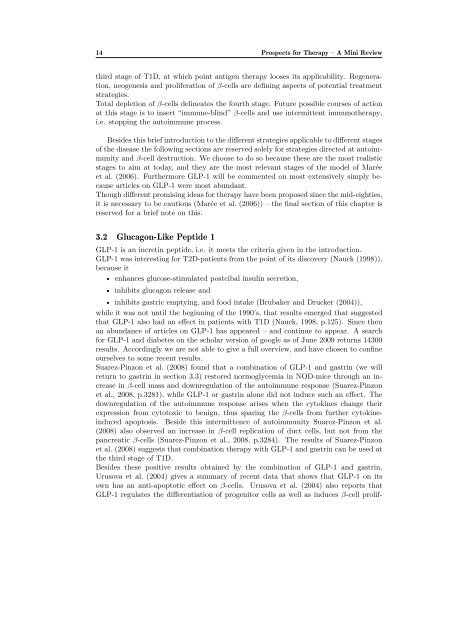nr. 477 - 2011 - Institut for Natur, Systemer og Modeller (NSM)
nr. 477 - 2011 - Institut for Natur, Systemer og Modeller (NSM)
nr. 477 - 2011 - Institut for Natur, Systemer og Modeller (NSM)
You also want an ePaper? Increase the reach of your titles
YUMPU automatically turns print PDFs into web optimized ePapers that Google loves.
14 Prospects <strong>for</strong> Therapy – A Mini Review<br />
third stage of T1D, at which point antigen therapy looses its applicability. Regeneration,<br />
ne<strong>og</strong>enesis and proliferation of β-cells are defining aspects of potential treatment<br />
strategies.<br />
Total depletion of β-cells delineates the fourth stage. Future possible courses of action<br />
at this stage is to insert “immune-blind” β-cells and use intermittent immunotherapy,<br />
i.e. stopping the autoimmune process.<br />
Besides this brief introduction to the different strategies applicable to different stages<br />
of the disease the following sections are reserved solely <strong>for</strong> strategies directed at autoimmunity<br />
and β-cell destruction. We choose to do so because these are the most realistic<br />
stages to aim at today, and they are the most relevant stages of the model of Marée<br />
et al. (2006). Furthermore GLP-1 will be commented on most extensively simply because<br />
articles on GLP-1 were most abundant.<br />
Though different promising ideas <strong>for</strong> therapy have been proposed since the mid-eighties,<br />
it is necessary to be cautious (Marée et al. (2006)) – the final section of this chapter is<br />
reserved <strong>for</strong> a brief note on this.<br />
3.2 Glucagon-Like Peptide 1<br />
GLP-1 is an incretin peptide, i.e. it meets the criteria given in the introduction.<br />
GLP-1 was interesting <strong>for</strong> T2D-patients from the point of its discovery (Nauck (1998)),<br />
because it<br />
• enhances glucose-stimulated postcibal insulin secretion,<br />
• inhibits glucagon release and<br />
• inhibits gastric emptying, and food intake (Brubaker and Drucker (2004)),<br />
while it was not until the beginning of the 1990’s, that results emerged that suggested<br />
that GLP-1 also had an effect in patients with T1D (Nauck, 1998, p.125). Since then<br />
an abundance of articles on GLP-1 has appeared – and continue to appear. A search<br />
<strong>for</strong> GLP-1 and diabetes on the scholar version of go<strong>og</strong>le as of June 2009 returns 14300<br />
results. Accordingly we are not able to give a full overview, and have chosen to confine<br />
ourselves to some recent results.<br />
Suarez-Pinzon et al. (2008) found that a combination of GLP-1 and gastrin (we will<br />
return to gastrin in section 3.3) restored norm<strong>og</strong>lycemia in NOD-mice through an increase<br />
in β-cell mass and dow<strong>nr</strong>egulation of the autoimmune response (Suarez-Pinzon<br />
et al., 2008, p.3281), while GLP-1 or gastrin alone did not induce such an effect. The<br />
dow<strong>nr</strong>egulation of the autoimmune response arises when the cytokines change their<br />
expression from cytotoxic to benign, thus sparing the β-cells from further cytokineinduced<br />
apoptosis. Beside this intermittence of autoimmunity Suarez-Pinzon et al.<br />
(2008) also observed an increase in β-cell replication of duct cells, but not from the<br />
pancreatic β-cells (Suarez-Pinzon et al., 2008, p.3284). The results of Suarez-Pinzon<br />
et al. (2008) suggests that combination therapy with GLP-1 and gastrin can be used at<br />
the third stage of T1D.<br />
Besides these positive results obtained by the combination of GLP-1 and gastrin,<br />
Urusova et al. (2004) gives a summary of recent data that shows that GLP-1 on its<br />
own has an anti-apoptotic effect on β-cells. Urusova et al. (2004) also reports that<br />
GLP-1 regulates the differentiation of pr<strong>og</strong>enitor cells as well as induces β-cell prolif-
















